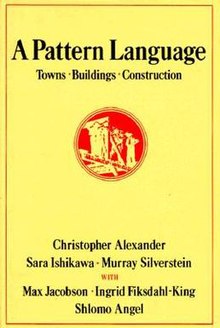 | |
| Author | Christopher Alexander, Sara Ishikawa, Murray Silverstein |
|---|---|
| Subject | Architecture |
| Publisher | Oxford University Press |
Publication date | 1977 |
| Pages | 1071 |
| ISBN | 0-19-501919-9 |
| LC Class | HT166.A6147 |
| Preceded by | The Timeless Way of Building |
| Followed by | The Oregon Experiment |
A Pattern Language: Towns, Buildings, Construction is a 1977 book on architecture, urban design, and community livability. It was authored by Christopher Alexander, Sara Ishikawa and Murray Silverstein of the Center for Environmental Structure of Berkeley, California, with writing credits also to Max Jacobson, Ingrid Fiksdahl-King and Shlomo Angel. Decades after its publication, it is still one of the best-selling books on architecture.[1]
The book creates a new language, what the authors call a pattern language derived from timeless entities called patterns. As they write on page xxxv of the introduction, "All 253 patterns together form a language." Patterns describe a problem and then offer a solution. In doing so the authors intend to give ordinary people, not only professionals, a way to work with their neighbors to improve a town or neighborhood, design a house for themselves or work with colleagues to design an office, workshop, or public building such as a school.